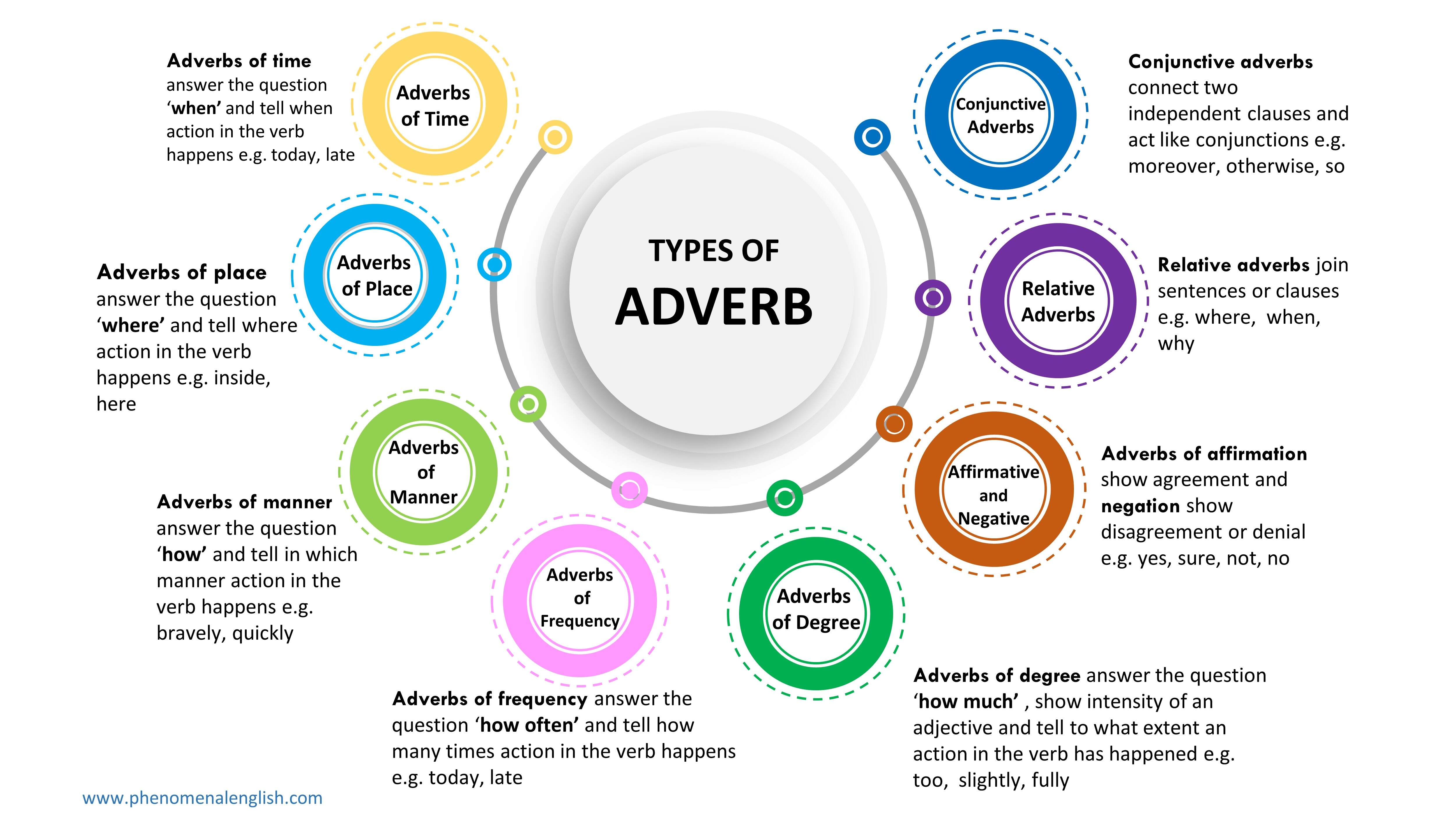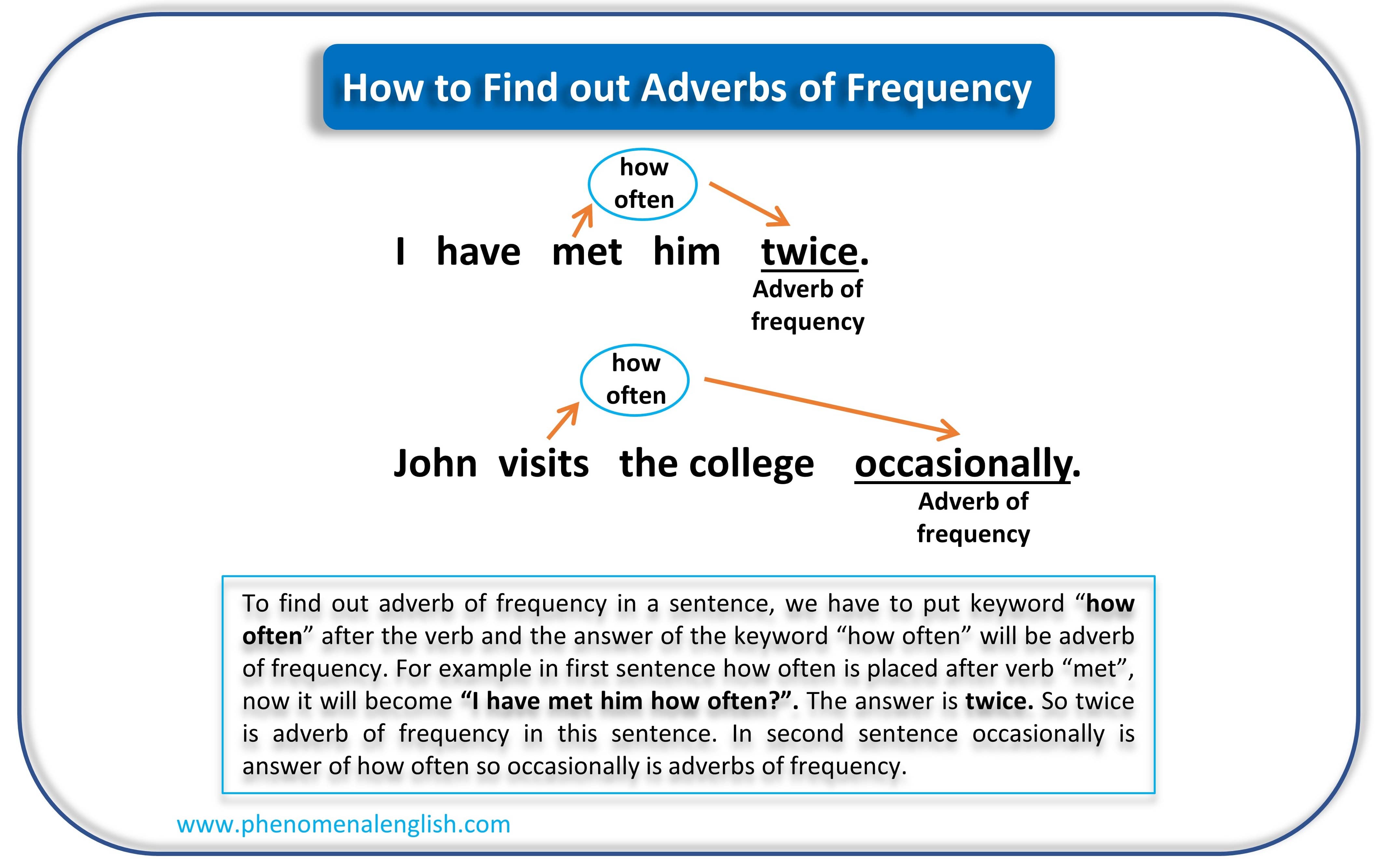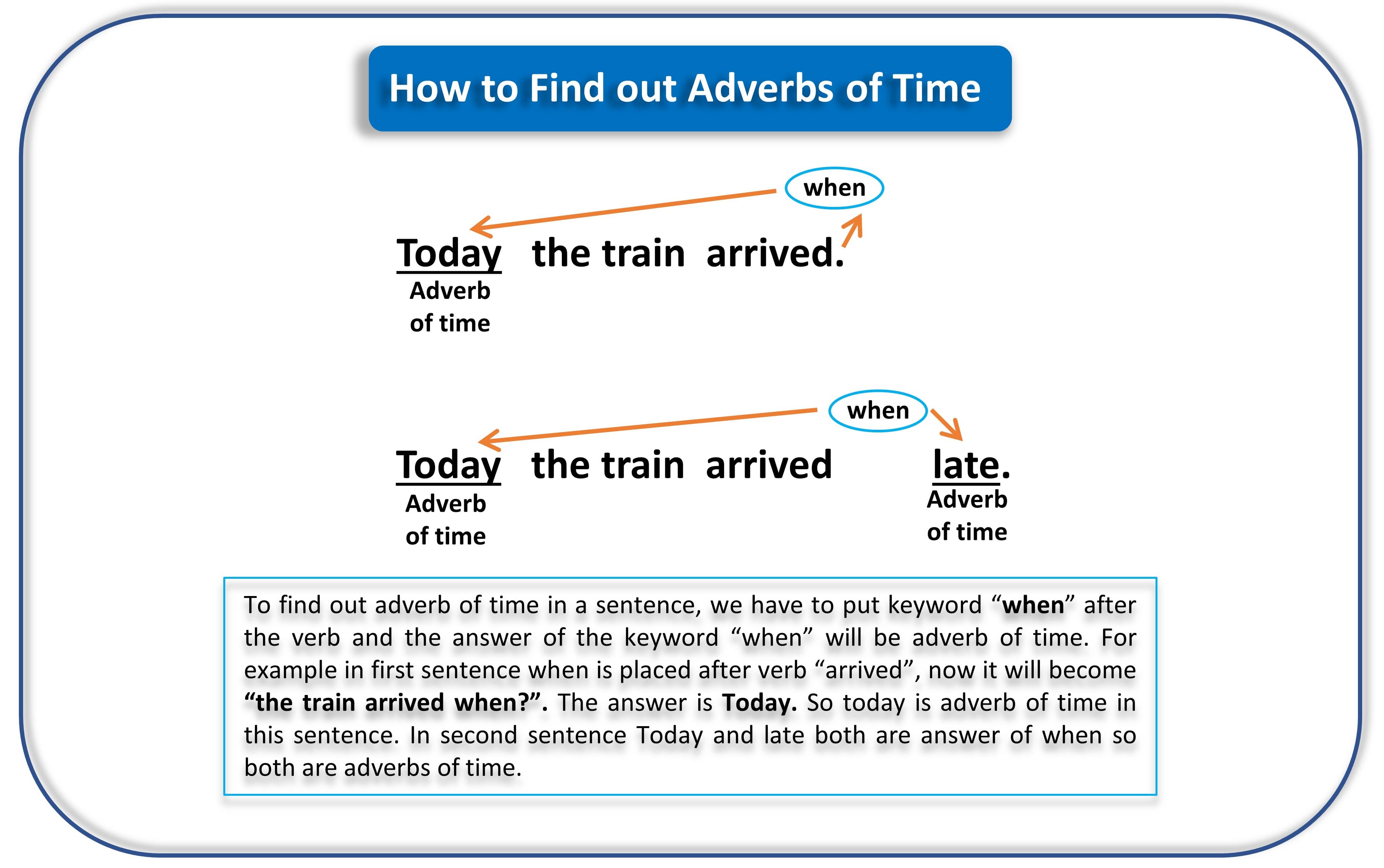What is an Adverb
Table of Contents
Main Topics
This article contains adverb its definition, types, position, order, degrees, usage, formation and examples to provide you complete guidance about adverbs.
Importance of Adverb
Adverbs are an essential part of language as they modify verbs, adjectives, and other adverbs. They help to provide more information about the manner, degree, time, frequency, and place of an action or event. Here are some reasons why adverbs are important:
- Provide clarity and specificity: Adverbs help to clarify and provide more precise information about how an action is being performed or when it is happening. For example, consider the sentence "He ran." Without an adverb, it is unclear how he ran or when he ran. However, with an adverb such as "quickly," the sentence becomes more specific and clearer, "He ran quickly."
- Enhance meaning: Adverbs can add emphasis and enhance the meaning of a sentence. For instance, adding the adverb "completely" to the sentence "He forgot to lock the door" can change the meaning to "He completely forgot to lock the door."
- Convey attitude or mood: Adverbs can be used to convey the speaker's attitude or mood towards the action or event being described. For example, "He reluctantly agreed" implies that he did not want to agree but did so anyway.
- Improve writing style: Adverbs can help to make writing more interesting and engaging by varying the sentence structure and providing additional details. However, it's important to use adverbs sparingly and appropriately to avoid overusing them and making writing appear repetitive or weak.
Definition of Adverb
Adverb is a word that modifies or describes a verb, adjective, or other adverb. It provides additional information about how, when, where, or to what extent an action or quality is performed.
Characteristics and Functions of Adverb
Adverbs have several characteristics that set them apart from other parts of speech. Here are some of the primary characteristics of adverbs:
- verbs, adjectives, and other adverbs: Adverbs are words that modify verbs, adjectives, or other adverbs. They provide additional information about how, when, where, and to what extent an action or event is taking place.
- Answer questions: Adverbs often answer questions such as how, when, where, why, and to what extent. For example, in the sentence "She sang beautifully," the adverb "beautifully" answers the question of how she sang.
- End in -ly: Many adverbs are formed by adding the suffix -ly to an adjective. For example, "quickly" is the adverb form of "quick."
- Can be placed in different parts of a sentence: Adverbs can be placed at the beginning, middle, or end of a sentence. However, the placement of an adverb can affect the meaning of the sentence.
- Do not change form:Unlike adjectives, which can have different forms depending on the gender, number, and case of the noun they modify, adverbs do not change form. They remain the same regardless of the context in which they are used.
- Vary in degree: Adverbs can vary in degree, indicating the intensity or extent of the action or event being described. For example, "very" and "extremely" are adverbs that indicate a high degree or intensity.
In summary, adverbs are words that modify verbs, adjectives, or other adverbs, answer questions about how, when, where, why, and to what extent, and do not change form but can vary in degree.
Types of Adverb
Adverbs can be classified into several categories based on their function and the type of information they provide. Here are the main types of adverbs:


- Adverbs of manner: Adverbs of manner describe how an action is performed. Mostly they describe verbs and seldom adverbs and adjectives. To find out adverb of manner in a sentence, we have to put keyword “how” after the verb as is shown below in the following sentences and the answer of the keyword “how” will be adverb of manner. For example in first sentence how is placed after verb “completed”, now it will become “I have completed my task how?”. The answer is successfully. So successfully is adverb of manner in this sentence. In second bravely is answer of how so bravely is adverbs of manner.
List of Adverbs: quickly, slowly, happily, and sadly. - Adverbs of frequency: Adverbs of frequency describe how often an action occurs. Mostly they describe verbs and seldom adverbs and adjectives. To find out adverb of frequency in a sentence, we have to put keyword “how often” after the verb as is shown below in the following sentences and the answer of the keyword “how often” will be adverb of frequency. For example in first sentence how often is placed after verb “met”, now it will become “I have met him how often?”. The answer is twice. So twice is adverb of frequency in this sentence. In second sentence occasionally is answer of how often so occasionally is adverbs of frequency.
List of Adverbs: always, often, sometimes," and "rarely." - Adverbs of time: Adverbs of time describe when an action occurs. Mostly they describe verbs and seldom adverbs and adjectives. Generally they are placed in the beginning or end of a sentence. To find out adverb of time in a sentence, we have to put keyword “when” after the verb as is shown below in the following sentences and the answer of the keyword “when” will be adverb of time. For example in first sentence when is placed after verb “arrived”, now it will become “the train arrived when?”. The answer is Today. So today is adverb of time in this sentence. In second sentence Today and late both are answer of when so both are adverbs of time.
List of Adverbs: yesterday, today, soon, late, early etc. - Adverbs of place: Adverbs of place describe where an action occurs. They usually modify verbs and seldom adverbs or adjectives. To find out adverb of place in a sentence, we have to put keyword “where” after the verb as is shown below in the following sentences and the answer of the keyword “where” will be adverb of place. For example in first sentence when is placed after verb “sitting”, now it will become “John is sitting where?”. The answer is outside. So outside is adverb of place in this sentence. In second sentence here is answer of where so it is adverb of time.
- Adverbs of degree: Adverbs of degree describe the intensity or extent (how much) of an action or event. Examples include "very," "extremely," "quite," and "somewhat."
- Adverbs of affirmation and negation: Adverbs of affirmation indicate agreement or confirmation, such as "certainly," "indeed," and "absolutely." Adverbs of negation indicate negation or denial, such as "not," "never," and "no."
- Interrogative adverbs: Interrogative adverbs are used to ask questions about time, place, manner, or reason. Examples include "when," "where," "how," and "why."
- Relative adverbs: Relative adverbs are used to connect two clauses in a sentence and indicate a relationship between them. Examples include "where," "when," and "why."
- Conjunctive adverbs: Conjunctive adverbs are used to connect two independent clauses in a sentence. Examples include "however," "therefore," and "moreover."






List of Adverbs: here, there, everywhere, nowhere.


Some adverbs can belong to multiple categories, depending on their usage and context.
Position of Adverbs
Adverbs can be placed in different parts of a sentence depending on the intended meaning and the type of adverb. Here are some general rules for the position of adverbs in a sentence:
- When an adverb qualifies an intransitive verb, it is placed immediately after the verb it qualifies. For example
- He works well
- James lives there.
Here work is an intransitive verb and well an adverb comes immediately after it.
Here lives is an intransitive verb and there an adverb comes immediately after it.
-
When an adverb qualifies a transitive verb, it is placed either before the verb it qualifies or after the object.. For
example
- He adamantly completed this project.
- He completed this project adamantly.
Here adamantly is an adverb qualifing completed a transitive verb, so it can either be placed before verb or after the object.
- An adverb of manner normally comes after the verb or the object. For example,
- He fought bravely.
- He wrote this book perfectly.
Here fought is a verb and bravely an adverb comes generally after it.
Here wrote is a verb and perfectly an adverb comes after the object book.
- An adverbs of time often comes at the beginning or end of a sentence, or seldom it comes before the main verb. For example
- Yesterday, I went to the store
- I went to the store yesterday.
Here yesterday is an adverb and comes at the beginning or at the end of the sentence.
- An adverb of degree usually comes before the adjective or adverb it modifies. For example
- He is extremely talented.
- She runs very fast.
Here talented is a past participle adjective and extremely an adverb modifying it comes before it.
Here fast is an averb and very is also an adverb modifying fast comes before it.
- An adverbs of place usually comes after the verb it modifies or after the object of that sentence. For example
- She looked everywhere.
- Come here.
Here in the above mentioned sentence everywhere is an adverb of place modifying a verb looked comes immediately after it. it.
Above mentioned sentence is an imperative sentence. 'here' is an averb of place modifying a verb 'come' occures immediately after it.
- If a verb consists of helping verb and principal verb then an adverb of manner, affirmation or negation must occure between helping verb and principal verb. For example
- He did not write his assignment.
- He has successfully completed his mission.
Here not an adverb falls between did (helping verb) and write (verb).
Here successfully an adverb falls between has (helping verb) and completed (verb).
These rules are not absolute and can vary depending on the context and intended meaning of the sentence. Also, the placement of an adverb can affect the emphasis and tone of a sentence. Therefore, it's essential to use adverbs judiciously and appropriately to convey the intended meaning and tone.
Order of Adverbs
The order of adverbs in a sentence can also affect the meaning and clarity of a sentence. Here are some general guidelines for the order of adverbs in a sentence:
- Adverbs of manner usually come first, followed by adverbs of place, and then adverbs of time. For example, "She danced gracefully on the stage last night."
- Adverbs of frequency usually come before adverbs of manner, but after adverbs of time. For example, "He rarely eats fast food anymore."
- Adverbs of degree usually come before adverbs of manner, and after adverbs of frequency or time. For example, "She always speaks very softly to the children."
- Multiple adverbs of the same type can be used in a sentence, but they usually follow the general order listed above. For example, "He ran quickly and gracefully down the track."
These guidelines are not strict rules, and the order of adverbs can vary depending on the intended meaning and emphasis of a sentence.
Degrees of Adverbs
Adverbs can also have degrees of comparison, similar to adjectives. The three degrees of comparison for adverbs are:
- Positive degree: This is the basic form of the adverb, used to describe the action or state of being without making a comparison. For example, "He sings well."
- Comparative degree: This form of the adverb is used to compare two actions or states of being. The comparative form is usually formed by adding "-er" to the end of the adverb or by using "more" before the adverb. For example, "She sings better than he does" or "He sings more loudly than she does."
- Superlative degree: This form of the adverb is used to compare three or more actions or states of being. The superlative form is usually formed by adding "-est" to the end of the adverb or by using "most" before the adverb. For example, "She sings the best of all the contestants" or "He sings the most beautifully of all."
However, not all adverbs can be compared in all three degrees. Some adverbs only have a positive degree, while others have irregular comparative and superlative forms. For example, the adverb "well" has the comparative form "better" and the superlative form "best," while the adverb "fast" has the comparative form "faster" and the superlative form "fastest."
Usages of Adverbs
Adverbs are versatile words that can perform a variety of functions in a sentence. Here are some of the most common functions of adverbs:
- Modifying verbs: The most common function of adverbs is to modify verbs. Adverbs of manner, time, place, degree, frequency, and purpose are all used to describe how, when, where, how much, how often, and why an action is done. For example, "She spoke loudly," "He arrived late," "They went there," "It's quite hot today," "I often visit my grandparents," and "He studies hard to pass his exams."
- Modifying adjectives: Adverbs can also modify adjectives, indicating the degree or intensity of a quality. For example, "She is extremely beautiful," "He is fairly tall," and "The food was incredibly delicious."
- Modifying other adverbs: Adverbs can also modify other adverbs, indicating the degree or intensity of an action or quality. For example, "She speaks very loudly," "He runs quite slowly," and "They were walking extremely quickly."
- Connecting clauses: Conjunctive adverbs can be used to connect two independent clauses. For example, "She was tired; however, she continued working."
- Introducing a sentence or clause: Certain adverbs can be used to introduce a sentence or clause, such as "indeed," "fortunately," and "unfortunately." For example, "Fortunately, the rain stopped just in time for the outdoor concert."
- Expressing an attitude: Some adverbs can express the speaker's attitude or opinion about something, such as "happily," "unfortunately," and "surprisingly." For example, "Happily, the couple was reunited after being separated for months."
- Asking questions: Interrogative adverbs are used to ask questions, such as "when," "where," and "why." For example, "When will you arrive?" and "Where did you go yesterday?"
- Emphasizing a point: Adverbs can be used to emphasize a point or draw attention to something, such as "clearly," "obviously," and "frankly." For example, "Clearly, the company needs to improve its customer service."
Formation of Adverbs
Adverbs are words that modify verbs, adjectives, or other adverbs. They are formed in a variety of ways depending on the word they are modifying. Here are some common ways adverbs are formed:
- Adding "-ly" to an adjective: This is the most common way to form an adverb. For example, "slow" becomes "slowly," "happy" becomes "happily," and "quick" becomes "quickly."
- Using the same form as the adjective: Some adjectives have the same form as adverbs. For example, "fast" is both an adjective and an adverb. "He drove fast" uses "fast" as an adverb.
- Adding "-wise" to a noun: This is a less common way to form adverbs, but it is still used. For example, "clockwise" and "lengthwise" are adverbs formed from the nouns "clock" and "length," respectively.
- Using a different word: Some adverbs are formed by using a completely different word than the adjective. For example, "well" is the adverb form of "good," and "badly" is the adverb form of "bad."
- Using irregular forms: Some adverbs have irregular forms that do not follow any particular pattern. For example, "hard" becomes "hardly" and "fast" becomes "fast" (as mentioned earlier).
- Adding "-ly" to the noun: This is the most common way to form an adverb from a noun. For example, "quick" becomes "quickly," "happy" becomes "happily," and "loud" becomes "loudly."
- Using the same form as the noun: Some nouns have the same form as adverbs. For example, "fast" is both a noun and an adverb. "He ran fast" uses "fast" as an adverb.
- Using a preposition: Sometimes a preposition can be added to the noun to create an adverbial phrase. For example, "day" becomes "by day" in the phrase "He works by day."
- Adding a letter or a word before an adjective. For example "fresh" becomes "afresh" by adding a before it. like "asleep" , "aloud" , "alone". By adding word "be" before "low" it becomes "below" or "before".
- By adding a preposition after an adverb. For example "herewith" is formed by adding "with: after adverb "here" like hereby, thereupon.
- By adding a letter or a word before a noun. For example "bed" becomes "abed" by adding a before it. By adding word "be" before "side" it becomes "beside".
- By adding "-ly" to the present participles and past participles. For example "according" a present participle adjective becomes "accordingly" an adverb by adding "ly" after it. Past participle adjective "repeated" becomes "repeatedly" by adding "ly" after it.